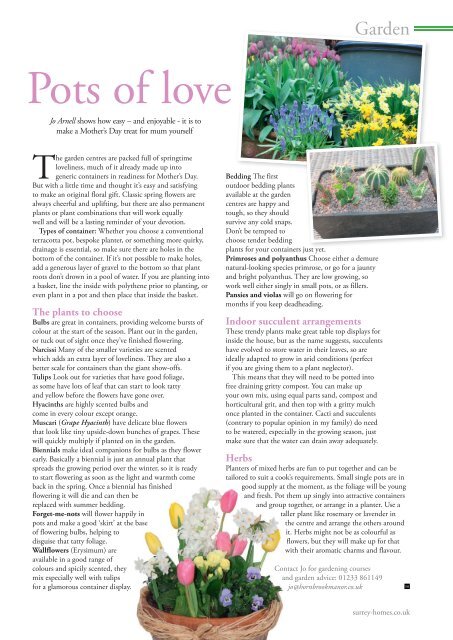Surrey Homes | SH41 | March 2018 | Fashion supplement inside
The lifestyle magazine for Surrey - Inspirational Interiors, Fabulous Fashion, Delicious Dishes
The lifestyle magazine for Surrey - Inspirational Interiors, Fabulous Fashion, Delicious Dishes
Create successful ePaper yourself
Turn your PDF publications into a flip-book with our unique Google optimized e-Paper software.
Garden<br />
Pots of love<br />
Jo Arnell shows how easy – and enjoyable - it is to<br />
make a Mother’s Day treat for mum yourself<br />
The garden centres are packed full of springtime<br />
loveliness, much of it already made up into<br />
generic containers in readiness for Mother’s Day.<br />
But with a little time and thought it’s easy and satisfying<br />
to make an original floral gift. Classic spring flowers are<br />
always cheerful and uplifting, but there are also permanent<br />
plants or plant combinations that will work equally<br />
well and will be a lasting reminder of your devotion.<br />
Types of container: Whether you choose a conventional<br />
terracotta pot, bespoke planter, or something more quirky,<br />
drainage is essential, so make sure there are holes in the<br />
bottom of the container. If it’s not possible to make holes,<br />
add a generous layer of gravel to the bottom so that plant<br />
roots don’t drown in a pool of water. If you are planting into<br />
a basket, line the <strong>inside</strong> with polythene prior to planting, or<br />
even plant in a pot and then place that <strong>inside</strong> the basket.<br />
The plants to choose<br />
Bulbs are great in containers, providing welcome bursts of<br />
colour at the start of the season. Plant out in the garden,<br />
or tuck out of sight once they’ve finished flowering.<br />
Narcissi Many of the smaller varieties are scented<br />
which adds an extra layer of loveliness. They are also a<br />
better scale for containers than the giant show-offs.<br />
Tulips Look out for varieties that have good foliage,<br />
as some have lots of leaf that can start to look tatty<br />
and yellow before the flowers have gone over.<br />
Hyacinths are highly scented bulbs and<br />
come in every colour except orange.<br />
Muscari (Grape Hyacinth) have delicate blue flowers<br />
that look like tiny upside-down bunches of grapes. These<br />
will quickly multiply if planted on in the garden.<br />
Biennials make ideal companions for bulbs as they flower<br />
early. Basically a biennial is just an annual plant that<br />
spreads the growing period over the winter, so it is ready<br />
to start flowering as soon as the light and warmth come<br />
back in the spring. Once a biennial has finished<br />
flowering it will die and can then be<br />
replaced with summer bedding.<br />
Forget-me-nots will flower happily in<br />
pots and make a good ‘skirt’ at the base<br />
of flowering bulbs, helping to<br />
disguise that tatty foliage.<br />
Wallflowers (Erysimum) are<br />
available in a good range of<br />
colours and spicily scented, they<br />
mix especially well with tulips<br />
for a glamorous container display.<br />
Bedding The first<br />
outdoor bedding plants<br />
available at the garden<br />
centres are happy and<br />
tough, so they should<br />
survive any cold snaps.<br />
Don’t be tempted to<br />
choose tender bedding<br />
plants for your containers just yet.<br />
Primroses and polyanthus Choose either a demure<br />
natural-looking species primrose, or go for a jaunty<br />
and bright polyanthus. They are low growing, so<br />
work well either singly in small pots, or as fillers.<br />
Pansies and violas will go on flowering for<br />
months if you keep deadheading.<br />
indoor succulent arrangements<br />
These trendy plants make great table top displays for<br />
<strong>inside</strong> the house, but as the name suggests, succulents<br />
have evolved to store water in their leaves, so are<br />
ideally adapted to grow in arid conditions (perfect<br />
if you are giving them to a plant neglector).<br />
This means that they will need to be potted into<br />
free draining gritty compost. You can make up<br />
your own mix, using equal parts sand, compost and<br />
horticultural grit, and then top with a gritty mulch<br />
once planted in the container. Cacti and succulents<br />
(contrary to popular opinion in my family) do need<br />
to be watered, especially in the growing season, just<br />
make sure that the water can drain away adequately.<br />
Herbs<br />
Planters of mixed herbs are fun to put together and can be<br />
tailored to suit a cook’s requirements. Small single pots are in<br />
good supply at the moment, as the foliage will be young<br />
and fresh. Pot them up singly into attractive containers<br />
and group together, or arrange in a planter. Use a<br />
taller plant like rosemary or lavender in<br />
the centre and arrange the others around<br />
it. Herbs might not be as colourful as<br />
flowers, but they will make up for that<br />
with their aromatic charms and flavour.<br />
Contact Jo for gardening courses<br />
and garden advice: 01233 861149<br />
jo@hornbrookmanor.co.uk<br />
surrey-homes.co.uk


















